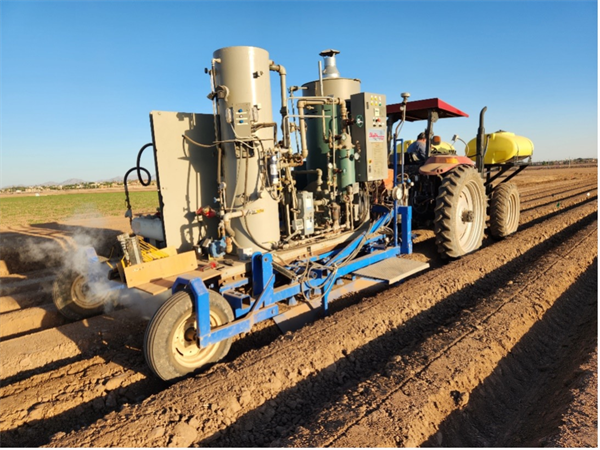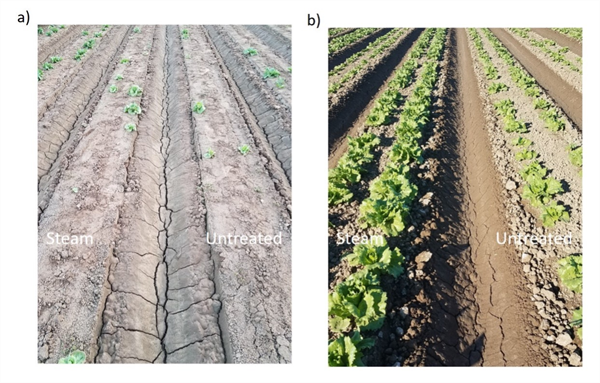Last week, we initiated our first trial of the season examining the use of band steam for controlling Fusarium wilt of lettuce. The premise behind this research is to use steam heat to raise soil temperatures to levels sufficient to kill soilborne pathogens. For Fusarium oxysporum f. sp. lactucae (FOL) the pathogen which causes Fusarium wilt of lettuce, the required temperature for control is generally taken to be > 140°F for 20 minutes. Soil solarization, where clear plastic is placed over the crop bed during the summer, exploits this concept. The technique raises soil surface temperatures to 150-155˚F, effectively killing the pathogen and reducing FOL disease incidence by 45-98% (Matheron and Porchas, 2010).
In our trials, we are using steam heat to raise soil temperatures. Steam is delivered by a 35 BHP steam generator mounted on a custom designed elongated bed shaper (Fig. 1). As the device travels through the field, steam is injected into the soil in narrow bands centered on the seedline. Soil temperatures are raised to about 190°F. After cooling (< ½ a day), the crop is planted into the disinfested soil.
Trials conducted in prior years show the technique holds promise; however further work is needed. In these studies, a 4” wide by 2” deep band of soil was treated. Although soil assay results showed that steam treatment significantly reduced the number of Fusarium colony forming units by over 95% as compared to the untreated control, this didn’t always translate into reductions in disease incidence. At one field site with a known history of FOL, band-steam provided no benefit with virtually all lettuce plants succumbing to the disease (Fig 2a). However, at another site, disease incidence was reduced by more than 40%, plants appeared to be healthier and more vigorous, and yield was increased by more than 90% (Fig. 2b). One explanation for this difference is that at the first site, Fusarium inoculum loads were very high and the width and/or depth of soil treated by steam wasn’t large enough to protect seedling roots, which are highly susceptible to FOL, from infection. The aim of this year’s trial is to determine the width and depth of soil that needs to be disinfested to prevent disease. In the current study, we are examining bands of soil receiving steam treatment that range in size from 4” wide by 2” deep to 6” wide by 4” deep.
Stay tuned for final trial results and reports of our other studies examining the efficacy of using steam heat to control sclerotinia lettuce drop, pythium and weeds.
As always, if you are interested in trying band-steam on your farm or would like more information, please feel free to contact me.
References
Matheron, M. E., & Porchas, M. 2010. Evaluation of soil solarization and flooding as management tools for Fusarium wilt of lettuce. Plant Dis. 94:1323-1328.
Acknowledgements
This project is sponsored by USDA-NIFA, the Arizona Specialty Crop Block Grant Program and the Arizona Iceberg Lettuce Research Council. We greatly appreciate their support.
A special thank you is extended to Fatima Corona, Roberto Delgado, Chad VanMatre, Matt McGuire and JV Farms for their generous assistance and allowing us to conduct this research on their farm.

Fig. 1. Band-steam applicator principally comprising a 35 BHP steam generator
mounted on a bed-shaper applicator sled. The device injects steam into the soil
as beds are formed.

Fig. 2. Lettuce seedlings at field sites with (a) very high and (b)
moderate levels of Fusarium wilt of lettuce inoculum. Band-steam
(left) and untreated (right) plots are shown.





